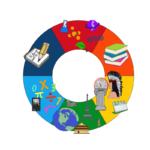VISUAL NOTE TAKING: draw images or doodles in place of taking notes by text to retain information
learning skilLS
Auditory Memory
Sustained Attention
Organization

instructional strategy
Visual Note Taking
Draw images or doodles in place of taking notes by text to retain information
_________
LEARNING PREFERENCES
academic skill
Listening Comprehension
Grade 6 – 9
Select and use a variety of listening strategies to comprehend information communicated orally and non-verbally

| Grade | Curriculum Focus | |||||
| 6-9 | Select and use a variety of listening strategies before, during, and after listening to comprehend information communicated orally and non-verbally, seek clarification, and develop a relevant response appropriate to the context. | |||||
Lesson Objective, Goal and Success Criteria


UDL Instruction



Differentiated Instruction

Measurement of Success

Materials, References and Resources
Supplemental Documents
Karaoke Activity
| Song | Karaoke YouTube Link | Year, Timing |
| Roar by Katy Perry-powerful mental health message | https://www.youtube.com/watch?v=hMF4h0gYN-0 | 2020, 4:09 minutes |
| Listen for the word “down” – it appears 4 times Listen for the word “champion”- it appears 6 times Listen for the word “hear”- it appears 17 times | ||
“ROAR” Lyrics
| Song | Karaoke YouTube Link | Year, Timing |
| Count on Me by Bruno Mars-message of friend and loyalty | https://www.youtube.com/watch?v=DC3LY7K7WOI | 2020, 3:43 minutes |
| Listen for the word, “friends”- it appears 5 times Listen for the word, “need” – it appears 5 times Listen for the word, “three” – it appears 6 times | ||
“Count on Me” Lyrics
| Song | Karaoke YouTube Link | Year, Timing |
| This is Me from the Greatest Showman-feeling good empowering message | https://www.youtube.com/watch?v=V59psMbygfI | 2018, 4:13 minutes |
| Listen to the word- “wanna”- it appears 4 times Listen to the word- “flood”- it appears 5 times | ||
“This is Me“ Lyrics
